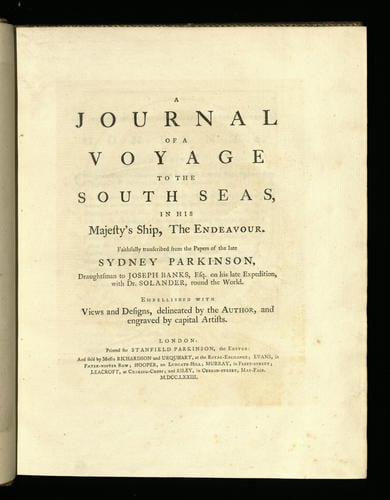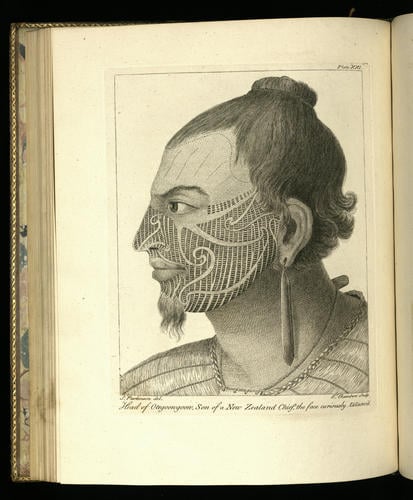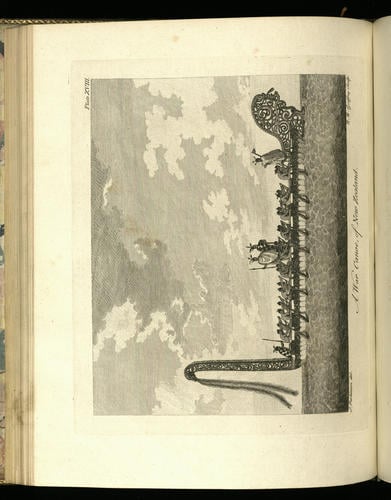-
1 of 253523 objects
A Journal of a voyage to the south seas, in His Majesty's ship, the Endeavour / transcribed from the papers of... Sydney Parkinson. 1773
34.9 x 28.7 x 3.1 cm (book measurement (conservation)) | RCIN 1125321

Sydney Parkinson (1745?-71)
A Journal of a voyage to the south seas, in His Majesty's ship, the Endeavour / transcribed from the papers of. . . Sydney Parkinson 1773

Sydney Parkinson (1745?-71)
A Journal of a voyage to the south seas, in His Majesty's ship, the Endeavour / transcribed from the papers of. . . Sydney Parkinson 1773

Sydney Parkinson (1745?-71)
A Journal of a voyage to the south seas, in His Majesty's ship, the Endeavour / transcribed from the papers of. . . Sydney Parkinson 1773



-
This is a copy of the 1773 edition of Sydney Parkinson's Journal of a Voyage to the South Seas, an account of the first Pacific voyage of James Cook.
The 1769 transit of Venus was an important scientific event. It was hoped that the calculations gathered from this event, and from the previous transit in 1761, would enable astronomers to calculate the precise distance between the Earth and the Sun. This discovery would allow for better timekeeping both on land and at sea.To this end, the botanist Joseph Banks and the Royal Society petitioned George III to arrange an expedition to observe the transit in the Pacific Ocean. Banks accompanied by his friend, Daniel Solander, were to travel to Otaheite (now Tahiti) on board HM Bark Endeavour, under the command of James Cook. Not to miss an opportunity, the Admiralty issued a secret secondary goal: to try to discover the fabled Terra Australis incognita, the unknown southern continent, which, if found, its probable wealth could provide a boon to British interests overseas.
Banks had inherited a large sum of money from his father at a young age and funded a team of scientists and illustrators to travel with Solander and himself. The team consisted of two draughtsmen (Alexander Buchan and Sydney Parkinson), the scientist Hermann Spöring, two assistants (Peter Briscoe and James Roberts) and two Black servants whose names have not been recorded.
The expedition left Plymouth in August 1768, reaching Tahiti in April 1769, where, in early June, the observations of the transit were made. Endeavour left Tahiti soon after the transit and ventured westward. With the assistance of Tupaia, a Tahitian priest and navigator who accompanied the crew, the ship reached New Zealand in October 1769 and Cook charted the coastline of both islands to a remarkable degree of accuracy. Tupaia was also able to communicate with Māori communities in New Zealand, but these encounters were not without problems. Perhaps the most famous of these was Cook’s landing at the present-day city of Gisborne, on 7 October 1768 when, following a skirmish with the crew and a group of Māori, a farmer named Te Maro was killed. In 2019, a monument honouring his memory was constructed in the city.In April the following year, Endeavour reached the east coast of Australia and a landing was made at Botany Bay, where there was a brief skirmish with Aboriginal Australians living in the area. They then sailed up the east coast of Australia, reaching the Dutch port of Batavia (now Jakarta) in October 1770.
Aside from the loss of one of the draughtsmen, Alexander Buchan, from an epileptic seizure at Tierra del Fuego in April 1769, Cook had succeeded in not losing a single crewman to poor sanitation for the majority of the voyage. At Batavia however, conditions in the port resulted in the deaths of several men including Tupaia, Spöring and Parkinson. Once repairs were made, Endeavour set off from Batavia, reaching London in the summer of 1771.
Sydney Parkinson made over 1,000 drawings during the voyage and these, along with his observations, have proved invaluable to the study of the natural history and anthropology of Australia, New Zealand and the Pacific in the eighteenth century. As a result of his death, the many sketches and drawings, and the journal he kept, came into the possession of Banks as his employer. Banks also brought back many natural history specimens and examples of Pacific Islander and Indigenous Australian art, which he presented to several institutions and influential figures (including George III, who was presented with a hei-tiki that remains in the Royal Collection, RCIN 69263), as well as maintaining a collection at his home in Soho Square in LondonFollowing legal complications regarding the ownership of the journal (both Parkinson's family and Joseph Banks claimed ownership of the material). Banks offered to loan the journal to Parkinson's brother Stanfield. Unbeknownst to Banks, Stanfield arranged to have the journal published with engravings of some of his brother's drawings accompanied by a preface which attacked Banks's conduct throughout the whole affair. The book was published in 1773, and almost immediately, the physician, John Fothergill (a friend of Banks and the patron of Sydney Parkinson) bought the remaining copies in order to publish an explanatory notice to the preface, clearing Banks of the accusations. Fothergill's corrected edition took twenty years to publish, finally being printed in 1784.
Cook's achievements were admired by many in Europe and, following his death on Hawai'i during his third voyage to the Pacific, he was regarded as a national hero in Britain and the wider British Empire. However, the legacy of his encounters with Indigenous populations across the Pacific and the subsequent colonisation of the region by Europeans continues to be debated.Provenance
From the library of George IV at Carlton House
-
Creator(s)
(editor)(publisher)(bookseller)Acquirer(s)
-
Measurements
34.9 x 28.7 x 3.1 cm (book measurement (conservation))
35.0 x 28.8 x 3.5 cm (book measurement (conservation))